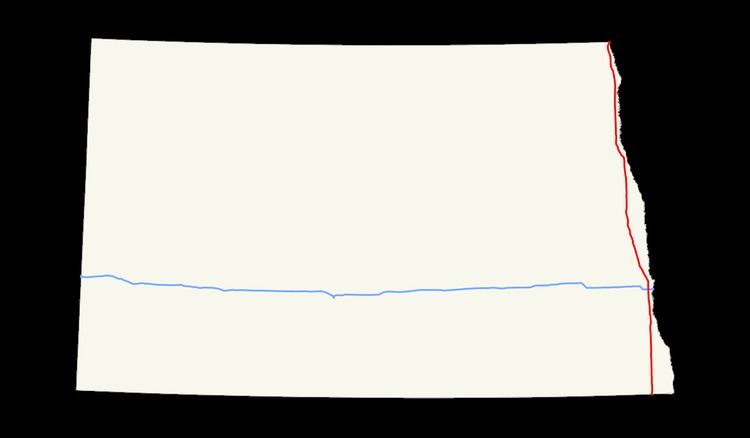Length 350.1 km | ||
 | ||
North end: PTH 75 at the Pembina–Emerson Border Crossing | ||
Interstate 29 (I-29) in the U.S. state of North Dakota runs from the state's southern border with South Dakota near Hankinson to the Canada–United States border just north of Pembina. The highway shares two concurrencies with U.S. Route 81 (US 81). The first begins in Watertown, South Dakota and remains concurrent with I-29 across the state line to Manvel. The other is from exit 203 to the Canada–US border. The highway runs somewhat parallel to the Minnesota border to the east and passes through two major cities, Fargo and Grand Forks.
Contents
South Dakota to Fargo
Interstate 29 enters North Dakota, with a speed limit of 75 miles per hour, from South Dakota to the south, travelling in a north-northeasterly direction. The first exit in the state, exit 1, is to a county road built along the state line. This exit serves the Dakota Magic Casino and Hotel. Rural exits are somewhat common in North Dakota. There are exits with no major communities near them about every eight miles from the South Dakota border to Fargo. There is also one exit serving ND 11 to Hankinson and one exit serving ND 13 to Wahpeton, North Dakota.
Fargo
I-29 has a speed limit of 55 miles per hour throughout the eight exits in Fargo, including interchanges with I-94 and US 10. There is also an exit that serves Hector International Airport. Farther north, there is an exit that indirectly serves Fargo via a north/south county road that mainly serves Harwood.
Fargo to Grand Forks
North of Fargo, with a speed limit of 75 miles per hour, there are exits roughly every six miles until the route enters Hillsboro. Interstate 29 has one exit south of the city serving its municipal airport and one exit serving the city itself. About six miles north of Hillsboro, the highway shares an interchange with ND 200, a major thoroughfare across central North Dakota. There are three more exits between Hillsboro and Grand Forks, including one serving Thompson, the southernmost suburb of Grand Forks.
Grand Forks
The highway has a speed limit of 75 miles per hour, and just four exits serving Grand Forks. One of them serves US 2, which leads to Grand Forks International Airport.
Grand Forks to Canada
With a speed limit of 75 miles per hour (121 km/h), 10 miles (16 km) north of the city, I-29's first concurrency with US 81 ends in Manvel. The highway's next exit is 10 miles (16 km) north of Manvel at an interchange with ND 54, which indirectly serves Oslo, Minnesota about three miles (4.8 km) east of the Interstate. There are a couple more minor exits between the Oslo exit and Drayton. The highway has two exits in Drayton, one with ND 44 and one with ND 66. After several more exits in the open country serving minor county highways, I-29 begins another concurrency with US 81 at an exit with ND 5. After one more exit serving a county road, the highways enter Pembina. In Pembina, I-29 has its final exit in the United States at an interchange with ND 59 and ND 171. Three miles (4.8 km) north of Pembina, I-29 and US 81 enter Manitoba, Canada, and become Manitoba Highway 75, which leads north to Winnipeg.
History
I-29 between Fargo and the Canadian border was originally meant to be signed as Interstate 31. There was no highway originally planned between Fargo and Sioux Falls, South Dakota. Plans for I-29 were extended from Sioux Falls to Fargo in October 1957, and the entire highway from Kansas City, Missouri to the Canadian border was signed as I-29. The final stages of I-29 in North Dakota were completed in 1977.
